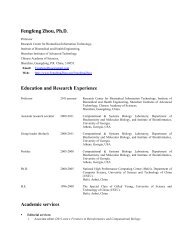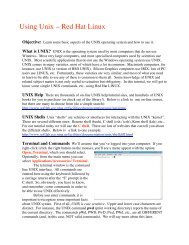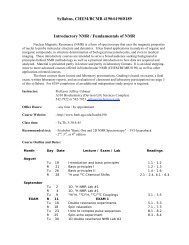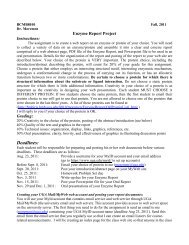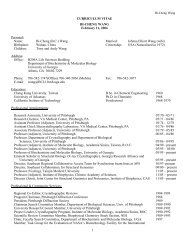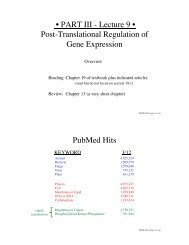Structural Basis for Recognition of the Intron Branch Site RNA by ...
Structural Basis for Recognition of the Intron Branch Site RNA by ...
Structural Basis for Recognition of the Intron Branch Site RNA by ...
Create successful ePaper yourself
Turn your PDF publications into a flip-book with our unique Google optimized e-Paper software.
compensating electrostatic interactions with <strong>the</strong><br />
solvent-exposed phosphate backbone <strong>of</strong> <strong>the</strong><br />
<strong>RNA</strong> (Figs. 2C and 3).<br />
R EPORTS<br />
The KH-QUA2/BPS <strong>RNA</strong> complex is stabilized<br />
<strong>by</strong> a combination <strong>of</strong> hydrophobic interactions,<br />
hydrogen bonding, and electrostatic<br />
contacts (Fig. 3A). Consistent with <strong>the</strong> conservation<br />
<strong>of</strong> <strong>the</strong> branch point adenosine in <strong>the</strong><br />
BPS, Ade8 is specifically recognized <strong>by</strong> <strong>the</strong> KH<br />
Fig. 2. Structure <strong>of</strong> <strong>the</strong> SF1/branch site <strong>RNA</strong><br />
complex. (A) Stereoview <strong>of</strong> <strong>the</strong> NMR ensemble<br />
<strong>of</strong> <strong>the</strong> SF1 KH-QUA2/BPS <strong>RNA</strong> complex. <strong>RNA</strong><br />
heavy atoms are shown in red; <strong>the</strong> N, C, C<br />
trace <strong>of</strong> <strong>the</strong> protein is shown in gray and colored<br />
blue <strong>for</strong> secondary structure elements. (B)<br />
Ribbon representation <strong>of</strong> <strong>the</strong> SF1 KH-QUA2<br />
domain bound to <strong>the</strong> BPS. Side chains <strong>of</strong> conserved<br />
hydrophobic core residues are shown in<br />
yellow; residues in <strong>the</strong> KH/QUA2 interface and<br />
<strong>the</strong> QUA2 helix 4 are colored magenta. The<br />
Gly-Pro-Arg-Gly motif and <strong>the</strong> variable loop <strong>of</strong><br />
<strong>the</strong> KH domain are colored green and red,<br />
respectively. (C) Ribbon and (D) surface representation<br />
<strong>of</strong> <strong>the</strong> KH-QUA2/BPS complex. Secondary<br />
structure elements <strong>of</strong> <strong>the</strong> KH-QUA2<br />
protein are labeled; <strong>RNA</strong> nucleotides are colored<br />
<strong>by</strong> atom type and annotated in magenta.<br />
The surface <strong>of</strong> <strong>the</strong> KH-QUA2 region is colored<br />
white, blue, and red <strong>for</strong> neutral, positive, and<br />
negative electrostatic potential, respectively.<br />
www.sciencemag.org SCIENCE VOL 294 2 NOVEMBER 2001 1099



